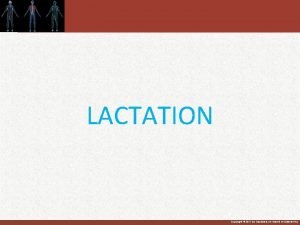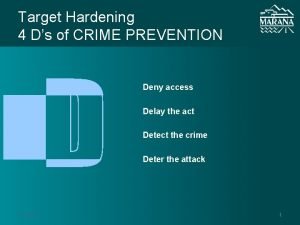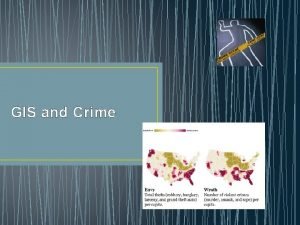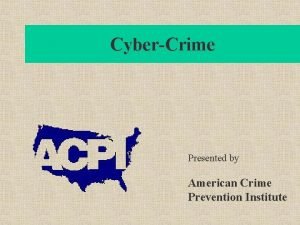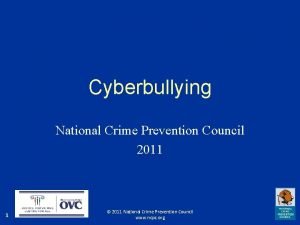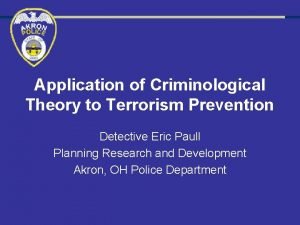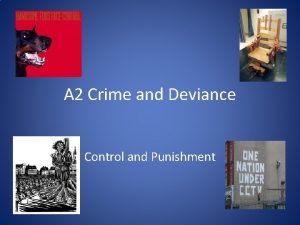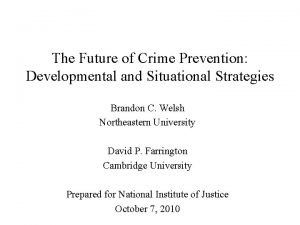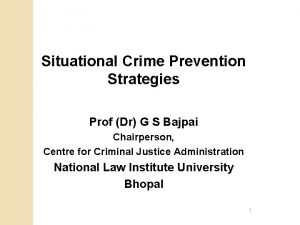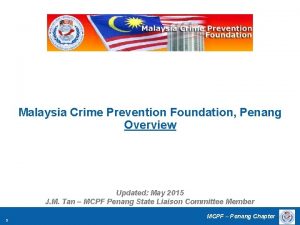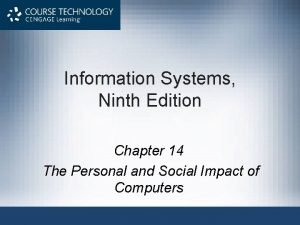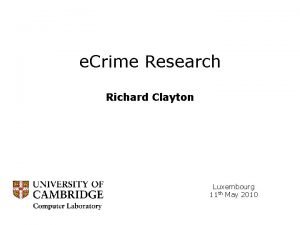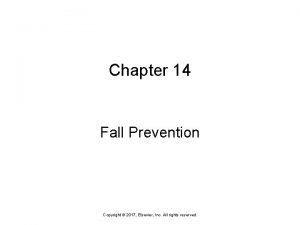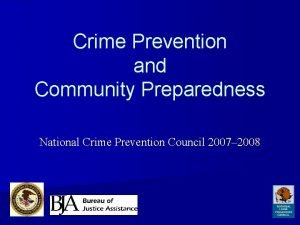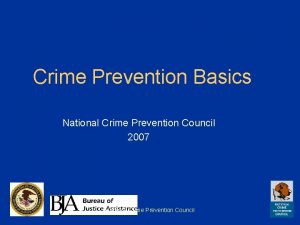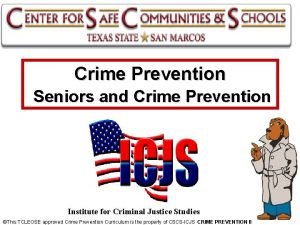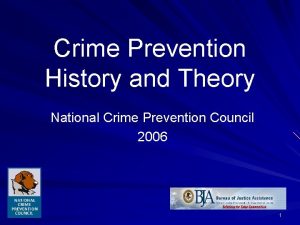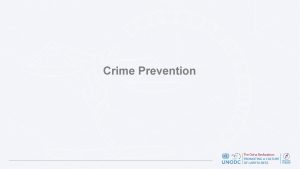Chapter 2 CRIME PREVENTION Copyright 2013 Elsevier Inc















- Slides: 15

Chapter 2 CRIME PREVENTION Copyright © 2013, Elsevier Inc. All Rights Reserved.

CRIME PREVENTION (CP) THROUGH THE AGES �Earliest responses to crime were left to the individual and his family �Retribution, revenge, and vengeance were the driving forces �Code of Hammurabi (approximately 1900 B. C. ) � outlined retribution by the victim and/or his family �Hammurabic law � Lex talionis, the principle of "an eye for an eye, " was specifically set forth as a driving principle Copyright © 2013, Elsevier Inc. All Rights Reserved.

CP THROUGH THE AGES �England 1066—obligatory form of avocational citizen policing � male citizens were required to band together into groups for the purpose of policing each other � watch and ward rotated the responsibility for keeping watch over the town or area, particularly at night, among the male citizens � watcher raised the alarm and call for help—hue and cry �Statutes of Winchester (1285) � required men to have weapons available for use when called—assize of arms � outlined the role of a constable Copyright © 2013, Elsevier Inc. All Rights Reserved.

CP THROUGH THE AGES �Vigilante movement in the U. S. � mirrored early ideas of "hue and cry" � major component of enforcing law and order in the growing frontier �Metropolitan Police in London (1829) � key was the idea of crime prevention Copyright © 2013, Elsevier Inc. All Rights Reserved.

Modern Crime Prevention �Traced to the changes in crime in the 1960 s � increases in crime and delinquency � large-scale social unrest �Architectural interest in physical design of communities � Jacobs’s (1961) “The Death and Life of Great American Cities” �focused on urban decay and the natural and social environments, and their impact on crime and deviance � Jeffery’s (1971) “Crime Prevention Through Environmental Design” �possible to curtail offending by removing environmental cues that reinforce the offending behavior Copyright © 2013, Elsevier Inc. All Rights Reserved.

Modern Crime Prevention � Newman’s (1972) “Defensible Space: People and Design in the Violent City” � called on architects to change the physical environment in such a way as to maximize territoriality and natural surveillance by residents and create an image of an area as cared for and protected � prompted the U. S. Department of Justice, other government agencies, and private corporations (such as Westinghouse Electric) to fund demonstration projects � Results of these projects led to the development of many different crime prevention efforts � neighborhood watch � "Take A Bite Out Of Crime" � citizen patrols � lighting projects Copyright © 2013, Elsevier Inc. All Rights Reserved.

Modern Crime Prevention �Situational Crime Prevention in 1983 � British Home Office � refocused attention from broad social/community change to target time- and place-specific efforts that would remove the opportunities for crime �Since the 1960 s there has been a growing movement toward bringing the citizenry back as active participants in crime prevention Copyright © 2013, Elsevier Inc. All Rights Reserved.

DEFINING CRIME PREVENTION �Ekblom (2005) � “Crime prevention is intervention in the causes of criminal and disorderly events to reduce the risks of their occurrence and/or the potential seriousness of their consequences. ” � addresses both crime and its impact on individuals and society �While most definitions of crime prevention incorporate the ideas of lessening the actual levels of crime or limiting further increases in crime, few deal with the problem of fear of crime and perceived crime and victimization Copyright © 2013, Elsevier Inc. All Rights Reserved.

DEFINING CRIME PREVENTION � Class working definition: � Crime prevention entails any action designed to reduce the actual level of crime and/or the perceived fear of crime. � Not restricted to the efforts of the criminal justice system and include activities by individuals and groups, both public and private � Crime prevention and crime control are not synonymous � crime control alludes to maintenance of a given or existing level and the management of that amount of behavior � control also fails to adequately address the problem of fear of crime Copyright © 2013, Elsevier Inc. All Rights Reserved.

CP CLASSIFICATIONS �Crime Prevention/Public Health Model � classifies prevention as either primary, secondary, or tertiary � Primary prevention �“identifies conditions of the physical and social environment that provide opportunities for or precipitate criminal acts” (Brantingham and Faust, 1976) � environmental design, neighborhood watch, general deterrence, private security, and education about crime and crime prevention Copyright © 2013, Elsevier Inc. All Rights Reserved.

CP CLASSIFICATIONS �Crime Prevention/Public Health Model (cont. ) � Secondary prevention �“engages in early identification of potential offenders and seeks to intervene” (Brantingham and Faust, 1976) � prior to commission of illegal activity � Implicit is the ability to correctly identify and predict problem people and situations � Most recognizable form of secondary prevention is the idea of situational crime prevention Copyright © 2013, Elsevier Inc. All Rights Reserved.

CP CLASSIFICATIONS �Crime Prevention/Public Health Model (cont. ) � Tertiary prevention �“deals with actual offenders and involves intervention. . . in such a fashion that they will not commit further offenses” Brantingham and Faust (1976) � majority of tertiary prevention rests within the workings of the criminal justice system � includes the activities of arrest, prosecution, incarceration, treatment, and rehabilitation Copyright © 2013, Elsevier Inc. All Rights Reserved.

CP CLASSIFICATIONS �Alternate Classifications � van Dijk and de Waard (1991) �add a second dimension resulting in a 3 -by-3 configuration of primary/secondary/tertiary on one axis and victimoriented/community-neighborhood-oriented/offenderoriented on the other axis � Crawford (1998) �offers two-dimensional typology that uses the primary/secondary/tertiary view as a starting point, and adds a distinction between social and situational approaches within each category Copyright © 2013, Elsevier Inc. All Rights Reserved.

CP CLASSIFICATIONS �Alternate Classifications (cont. ) � Hunter (2010) �divides crime prevention into micro, meso, and macro levels, while maintaining the primary, secondary, and tertiary distinctions �micro-level crime prevention targets individuals, small groups, small areas, or small businesses �meso-level prevention looks at larger communities or neighborhoods, or larger groups of individuals or businesses �macro-level crime prevention looks at large communities, society as a whole, or other very large collectives Copyright © 2013, Elsevier Inc. All Rights Reserved.

CP CLASSIFICATIONS �Alternate Classifications (cont. ) � Tonry and Farrington (1995) �divide crime prevention into four categories: developmental, community, situational, and criminal justice � Laycock (2005)—Crime Science �attacks crime from a wide range of disciplines (sociology, psychology, criminal justice, engineering, biology, physics, architecture, genetics, communications, computer science, education, and many others) using a broad array of tools �primary goal is to bring these divergent disciplines together into a functional, coordinated response to crime Copyright © 2013, Elsevier Inc. All Rights Reserved.
 Primary prevention secondary prevention tertiary prevention
Primary prevention secondary prevention tertiary prevention Galactokinesis
Galactokinesis 4 ds of security
4 ds of security Crimegis
Crimegis Crime prevention institute
Crime prevention institute National crime prevention council cyberbullying
National crime prevention council cyberbullying Situational crime prevention definition
Situational crime prevention definition Ron clarke 1992
Ron clarke 1992 Youth desk office saps
Youth desk office saps Developmental crime prevention
Developmental crime prevention 25 situational crime prevention techniques
25 situational crime prevention techniques Malaysia crime prevention foundation
Malaysia crime prevention foundation Crime prevention 9th edition
Crime prevention 9th edition Cyber crime prevention luxembourg
Cyber crime prevention luxembourg Mbti personal impact report
Mbti personal impact report 2013 pearson education inc
2013 pearson education inc

